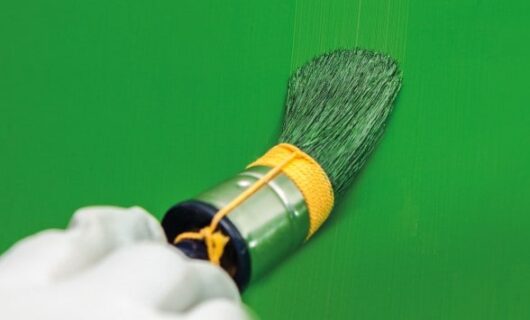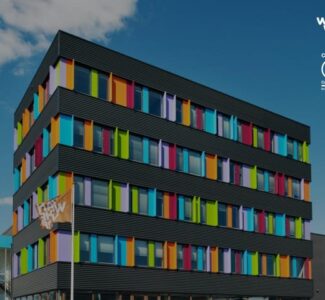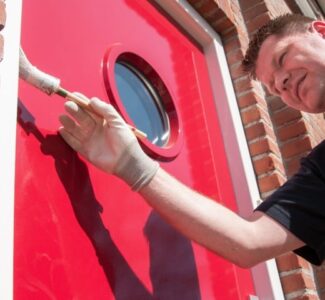Friday, June 3rd 2020
Sustainable paint has the longest lifespan. Sustainable paint contains the highest percentage of biobased (renewable) raw materials. Sustainable paint has the lowest CO2 footprint or causes the least environmental impact. Unfortunately, if it only was that simple. But the truth is – as so often – somewhere in the middle. A sustainable paint is created by the optimal mix of four factors: lifespan, biobased content, CO2 footprint and environmental impact.
Author: Menno Beek, Marketing Manager Koninklijke Van Wijhe Verf
Lifespan extension
Paint is traditionally intended to embellish, but above all to protect: it preserves real estate. And the better and longer the protection, the more durable the paint. That’s why paint producers are always looking for new raw materials and improved formulations to extend the lifespan of a paint system and to reduce maintenance intervals. After all, removing and repairing old layers of paint and applying new ones – with all the associated transport movements – contributes significantly to the CO2 footprint and environmental impact of a maintenance project. Nevertheless, a paint system with a longer lifespan is not necessarily sustainable. To be able to say something about this, you also need to know what’s in the container and how it got there.
Biobased raw materials
Until the middle of the last century, ‘biobased’ paint was the standard. Painting was based on linseed oil, and this oil comes from flax: an easy to grow and harvest crop. Wall paints were mostly made from lime. Pretty sustainable actually. A pity only of the limited lifespan and inefficient processing. Something better ought to be possible. And it could: with paint based on alkyd resin binding agents and acrylic dispersions. Alkyds have always been largely based on soy, but that doesn’t apply to the added solvents. Acrylics are also made from petroleum, but no one was aware of that at the time. The paint industry couldn’t get over it and came up with one development after the other: more gloss, faster drying, higher layer thickness, less solvents and above all: an increasingly higher quality and longer lifespan of the paintwork. At the same time, however, the uncomfortable awareness grew that the use of fossil raw materials had major drawbacks. Such as scarcity and the complicated extraction and processing that go hand in hand with environmental damage, CO2 emissions and fumes that are harmful to people. A solution was found in the reduction of solvents. In 2010, the quantity of solvents in paint was limited at European level. In recent years, R&D efforts have focused mainly on biobased paints ‘new style’ with sustainable, renewable raw materials that grow back faster than the lifespan of the paintwork. Of course, the performance of the paint remains the same or even better. Incidentally, a biobased paint is not automatically sustainable. The large-scale cultivation of vegetable raw materials at the expense of current food production or drinking water supplies is by no means sustainable. Just like raw materials that are transported all over the world with all the CO2 emissions and further environmental impact that comes with it. Also, the biobased content in paint does not say everything about the degree of sustainability; Ron Hulst wrote about this in a previous blog.
CO2 footprint
That brings me to the third factor: the CO2 footprint, i.e. the amount of CO2 per litre emitted to produce a particular paint. Not only during our own production process, but also when extracting, processing and transporting the necessary raw materials and paint. The CO2 footprint relates the composition, including the origin of the raw materials, to the production process and the life span of a paint. Clients and painters who want to make sustainable choices are therefore well advised to assess the relevant parameters in conjunction. As Koninklijke Van Wijhe Verf (Royal Van Wijhe Verf), we list all characteristics as standard in the sustainable facts of our paints. Transparent and clear for anyone who wants to know exactly what is going on.
Environmental impact
And then there is the environmental impact that cannot be captured in the CO2 footprint: all emissions and waste that – unlike CO2 – cannot be compensated by planting extra vegetation. Think of toxic substances and emissions caused during the entire production process (from growing and harvesting raw materials to the removal of old paintwork and the incineration/processing of waste). In other words: the waste flows within the entire chain. The extent to which this environmental burden is reduced, removed or reprocessed also determines the sustainability of a paint product. Whereas the other three factors can now be fairly easily expressed in terms of parameters, this is not the case for environmental impact. Instead, there are reputable, international certificates such as B Corp for companies that meet strict standards for social and environmental performance, accountability and transparency. But more on this in a later blog!



